
Love's Metamorphosis is an Elizabethan era stage play, an allegorical pastoral written by John Lyly. It was the last of his dramas to be printed.

Love's Metamorphosis is an Elizabethan era stage play, an allegorical pastoral written by John Lyly. It was the last of his dramas to be printed.
Love's Metamorphosis was entered into the Stationers' Register on 25 November 1600, and was first published in 1601 in a quarto issued by the bookseller William Wood. The title page of the 1601 quarto calls the play a "witty and courtly pastoral," and states that it was first staged by the Children of Paul's, the troupe of child actors that was Lyly's regular company, and "now" (c. 1600) by the Children of the Chapel. "Probably the Paul's boys produced it c. 1589–90, and the Chapel revived it in 1600–1." [1]
Love's Metamorphosis was left out of Six Court Comedies (1632), the first collected edition of Lyly's plays; and there is no evidence that it was ever a "Court comedy," that it was ever acted at Court. The play was not reprinted until F. W. Fairholt's 1858 edition of Lyly's collected works.
Lyly borrowed some elements for his play (the story of Erisichthon) from the Metamorphoses of Ovid, [2] and others from a 1588 prose pamphlet by Robert Greene, known alternatively as Greene's Metamorphosis and Alcida. Most of the play, however, is judged to be original with Lyly.
Set in Arcadia, the play's plot contains two strains: the main plot features Ceres and three of her nymphs, Nisa, Celia, and Niobe; the three foresters or shepherds who love them, Ramis, Montanus, and Silvestris; and Cupid. Cupid punishes the nymphs for their disdain of the shepherds, by transforming them into a rock, a rose, and a bird.
The subplot involves the churlish and brutal peasant Erisichthon, who chops down a sacred tree and thereby takes the life of Fidelia, a transformed nymph. Ceres punishes him with famine, and he responds by selling his daughter Protea to a merchant. Protea escapes her servitude via a prayer to Neptune and a disguise as a fisherman; she returns home, and masquerades as the revenging ghost of Ulysses to rescue Petulius, her beloved, from a Siren.
Ceres appeals to Cupid to release her nymphs; Cupid agrees, if Ceres will pardon Erisichthon. (The faithful love of Protea for Petulius has earned her Cupid's protection.) The nymphs are restored to their original forms once they agree to accept the three humans as husbands; the quadruple wedding is held at the house of Erisichthon.
Love's Metamorphosis differs from most of Lyly's plays in that it lacks the overtly comical and farcical elements that Lylian dramas normally possess. Strikingly, the play features none of the witty pages that are standard for Lyly. As a result, some critics have speculated that the extant text is a revised version of a more typical Lyly original.
The play is widely recognized as possessing a significant element of allegory, and is generally classed with Lyly's other allegorical works — though critics dispute the degree, meaning, and specific interpretation of the allegory. [3] The play's goddess figure, Ceres, has traditionally been taken to represent Queen Elizabeth I; yet some commentators have complained that unlike Sapho, or Cynthia in Endymion, Ceres doesn't much resemble Elizabeth in any substantive way.
The circumstances involving the play's nymphs and foresters have been defined as "Petrarchan situations," deriving from the sonnets of Petrarch as interpreted by sixteenth-century English poets in their sonnet sequences. [4]

The masque was a form of festive courtly entertainment that flourished in 16th- and early 17th-century Europe, though it was developed earlier in Italy, in forms including the intermedio. A masque involved music, dancing, singing and acting, within an elaborate stage design, in which the architectural framing and costumes might be designed by a renowned architect, to present a deferential allegory flattering to the patron. Professional actors and musicians were hired for the speaking and singing parts. Masquers who did not speak or sing were often courtiers: the English queen Anne of Denmark frequently danced with her ladies in masques between 1603 and 1611, and Henry VIII and Charles I of England performed in the masques at their courts. In the tradition of masque, Louis XIV of France danced in ballets at Versailles with music by Jean-Baptiste Lully.

Elizabethan literature refers to bodies of work produced during the reign of Queen Elizabeth I (1558–1603), and is one of the most splendid ages of English literature. In addition to drama and the theatre, it saw a flowering of poetry, with new forms like the sonnet, the Spenserian stanza, and dramatic blank verse, as well as prose, including historical chronicles, pamphlets, and the first English novels. Major writers include William Shakespeare, Edmund Spenser, Christopher Marlowe, Richard Hooker, Ben Jonson, Philip Sidney, and Thomas Kyd.

A Most pleasant Comedie of Mucedorus the Kings Sonne of Valentia, and Amadine the Kinges daughter of Aragon, commonly called Mucedorus, is an Elizabethan romantic comedy, first performed around 1590 and regularly revived until the Restoration. It was one of the most performed plays of its age, and 16 quarto editions were published between 1598 and 1668 making it the most widely printed play from the time. It was performed for both Queen Elizabeth and King James I. A revised and expanded version was published in 1610 with additional scenes.
Fair Em, the Miller's Daughter of Manchester, is an Elizabethan-era stage play, a comedy written c. 1590. It was bound together with Mucedorus and The Merry Devil of Edmonton in a volume labelled "Shakespeare. Vol. I" in the library of Charles II. Though scholarly opinion generally does not accept the attribution to William Shakespeare, there are a few who believe they see Shakespeare's hand in this play.
The Children of Paul's was the name of a troupe of boy actors in Elizabethan and Jacobean London. Along with the Children of the Chapel, they were an important component of the companies of boy players that constituted a distinctive feature of English Renaissance theatre.

The Maid's Metamorphosis is a late Elizabethan stage play, a pastoral first published in 1600. The play, "a comedy of considerable merit," was published anonymously, and its authorship has been a long-standing point of dispute among scholars.
Cynthia's Revels, or The Fountain of Self-Love is a late Elizabethan stage play, a satire written by Ben Jonson. The play was one element in the Poetomachia or War of the Theatres between Jonson and rival playwrights John Marston and Thomas Dekker.
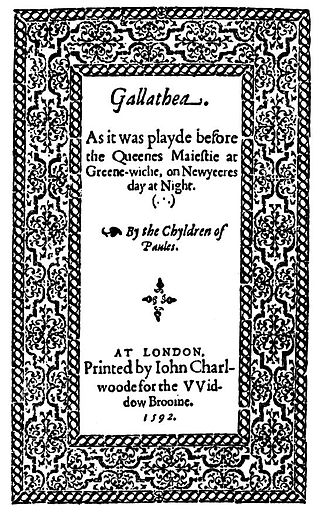
Gallathea or Galatea is an Elizabethan era stage play, a comedy by John Lyly. The first record of the play's performance was at Greenwich Palace on New Year's Day, 1588 where it was performed before Queen Elizabeth I and her court by the Children of St Paul's, a troupe of boy actors. At this point in his literary career, Lyly had already achieved success with his prose romance Euphues and was a writer in residence at Blackfriars theatre. The play is set in a village on the Lincolnshire shore of the river Humber and in the neighboring woods. It features a host of characters including Greek deities, Nymphs, fairies, and some shepherds.
William Shakespeare (1564–1616) was an English poet and playwright. He wrote approximately 39 plays and 154 sonnets, as well as a variety of other poems.
Thomas Creede was a printer of the Elizabethan and Jacobean eras, rated as "one of the best of his time." Based in London, he conducted his business under the sign of the Catherine Wheel in Thames Street from 1593 to 1600, and under the sign of the Eagle and Child in the Old Exchange from 1600 to 1617. Creede is best known for printing editions of works in English Renaissance drama, especially for ten editions of six Shakespearean plays and three works in the Shakespeare Apocrypha.

Endymion, the Man in the Moon is an Elizabethan era comedy by John Lyly, written circa 1588. The action of the play centers around a young courtier, Endymion, who is sent into an endless slumber by Tellus, his former lover, because he has spurned her to worship the ageless Queen Cynthia. The prose is characterised by Euphuism, Lyly's highly ornate, formalised style, meant to convey the intelligence and wit of the speaker. Endymion has been called "without doubt, the boldest in conception and the most beautiful in execution of all Lyly's plays." Lyly makes allusions to ancient Greek and Roman texts and traditional English folklore throughout the play. While the title and characters are references to the myth of Endymion, the plot sharply deviates from the classical story and highlights contemporary issues in Elizabeth I's court through its allegorical framework.
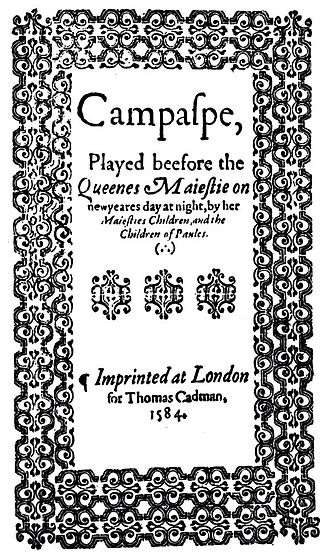
Campaspe is an Elizabethan era stage play, a comedy by John Lyly based on the life of Campaspe. Widely considered Lyly's earliest drama, Campaspe was an influence and a precedent for much that followed in English Renaissance drama.
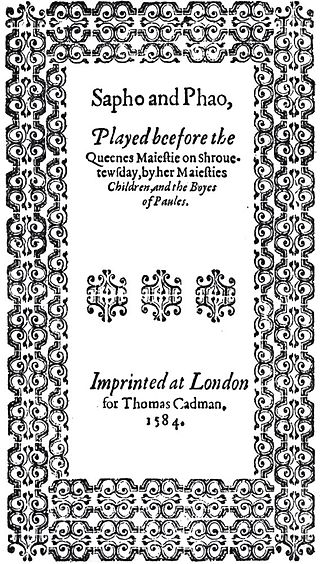
Sapho and Phao is an Elizabethan era stage play, a comedy written by John Lyly. One of Lyly's earliest dramas, it was likely the first that the playwright devoted to the allegorical idealisation of Queen Elizabeth I that became the predominating feature of Lyly's dramatic canon.
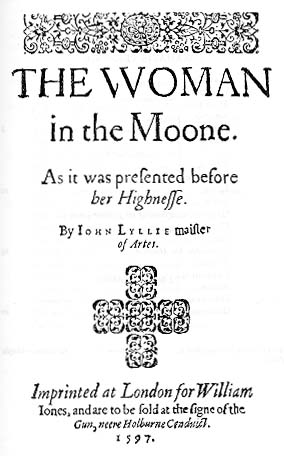
The Woman in the Moon is an Elizabethan era stage play, a comedy written by John Lyly. Its unique status in that playwright's dramatic canon – it is the only play Lyly wrote in blank verse rather than prose — has presented scholars and critics with a range of questions and problems.
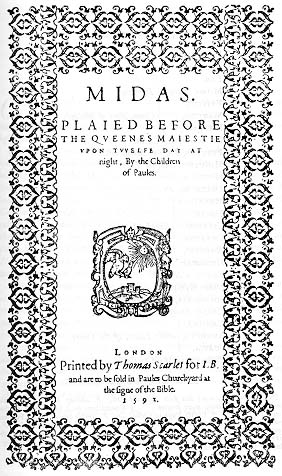
Midas is an Elizabethan era stage play, a comedy written by John Lyly. It is arguably the most overtly and extensively allegorical of Lyly's allegorical plays.
Summer's Last Will and Testament is an Elizabethan stage play, a comedy written by Thomas Nashe. The play is notable for breaking new ground in the development of English Renaissance drama: "No earlier English comedy has anything like the intellectual content or the social relevance that it has."
The Wisdom of Doctor Dodypoll is a later Elizabethan stage play, an anonymous comedy first published in 1600. It is illustrative of the type of drama staged by the companies of child actors when they returned to public performance in that era.
The Downfall of Robert Earl of Huntingdon and The Death of Robert Earl of Huntingdon are two closely related Elizabethan-era stage plays on the Robin Hood legend, that were written by Anthony Munday in 1598 and published in 1601. They are among the relatively few surviving examples of the popular drama acted by the Admiral's Men during the Shakespearean era.
The Lady of May is a one-act play by the English Renaissance poet Sir Philip Sidney. The play, which draws upon the literary tradition of pastoral, is notable for its allegorical content relating to Queen Elizabeth I, for whom the first production was performed at the Earl of Leicester's country estate at Wanstead. Queen Elizabeth was asked to mediate the outcome of the masque itself.
Love's Victory is a Jacobean era pastoral closet drama written circa 1620 by English Renaissance writer Lady Mary Wroth. The play is the first known original pastoral drama and the first original dramatic comedy written by a woman. It is written primarily in rhyming couplets. There are only two known manuscripts of Love's Victory, one of which is an incomplete version located in the Huntington Library in San Marino, California. The other version is complete, and is the Penshurst Manuscript which is owned by Viscount De L'Isle, indicating continued ownership by the Sidney family since its creation.